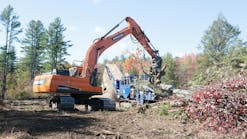SENSORS ARE INVISIBLE yet ubiquitous components of today’s urban landscape. These workhorses of the digital age can be as small as a sesame seed, yet precise enough to guide a self-driving car or detect harmful contaminants down to the sub-micron level. And in 2020, it’s estimated that about 300 billion sensors will enhance each of our daily lives.
Simply put, sensors convert physical conditions to an electronic signal, translating the world around us into a digital format. They can detect pressure, level, temperature, flow, and chemical composition, as well as a variety of other physical parameters. Today, an elaborate and ever-expanding web of embedded sensors, actuators, and data integration platforms are transforming the water industry by making our systems smarter and more efficient.
Advanced sensor technologies and IoT connectivity have together created a new kind of intelligent infrastructure. In water utilities around the world, networks of tiny wireless devices, paired with innovative aggregation and analytics platforms, are helping forward-looking organizations conserve resources, manage assets, optimize operations, and build more effective communications networks.
In the face of today’s limited water supplies, measuring, monitoring, and storing water is increasingly critical in order to optimize its usage. Therefore, in this issue of Water Efficiency, we provide an array of intelligent solutions with articles showcasing smart water strategies. Sensors, of course, form the intelligence layer that supports many of these strategies.
As environmental stress and population growth increase stress on water supplies, municipalities are doing their best to limit loss through practical solutions like advanced leak detection, infrastructure replacement plans, and leak isolation within district metered areas. In “Detecting Non-Revenue Water Loss” we outline the strategies that cities have found most effective for mitigating non-revenue water loss.
Water scarcity also makes it increasingly important for farmers to monitor, report, and apply water and nutrients with precision, as today they are held accountable for every drop. In “Intelligent Irrigation,” we explore the technologies supporting the digitization of irrigation such as digital weather stations; crop monitoring sensors to evaluate stress levels, plant growth, nutrient flow, and moisture levels; and drone technologies to enable aerial spectral analysis and infrared canopy mapping.
Software and digital controls are simplifying the process of managing the lifecycle of infrastructure and helping plant managers replace critical components before they fail. In “Streamlining Asset Management,” we look at ways that utilities are able to consolidate sensor-transmitted data from SCADA and GIS platforms and track the condition and maintenance schedules of infrastructure to make better-informed repair or replacement assessments.
South Bend, IA, was the first city in the world to build a city-wide network of sensors to monitor hydrologic behavior. In “The City of South Bend Gets Smart,” we showcase this complex network in which 152 monitoring sites and 13 automated gates and valves that are connected via the IoT monitor the precipitation, flow, and level of the city’s collection system to prevent sewer overflows.
By highlighting the sensors on pumps, pipelines, and valves that capture and convey data today, we celebrate the fresh opportunities for resource conservation and system optimization afforded by this connectivity.
Smart water systems and analytics-informed decision-making are not only improving plant performance and limiting non-revenue water losses in utilities, they are making water supplies more sustainable and communities more resilient. In this sense, sensors are not only translating the physical world, they are enhancing it. How do sensors and smart water technology support your system operations?



